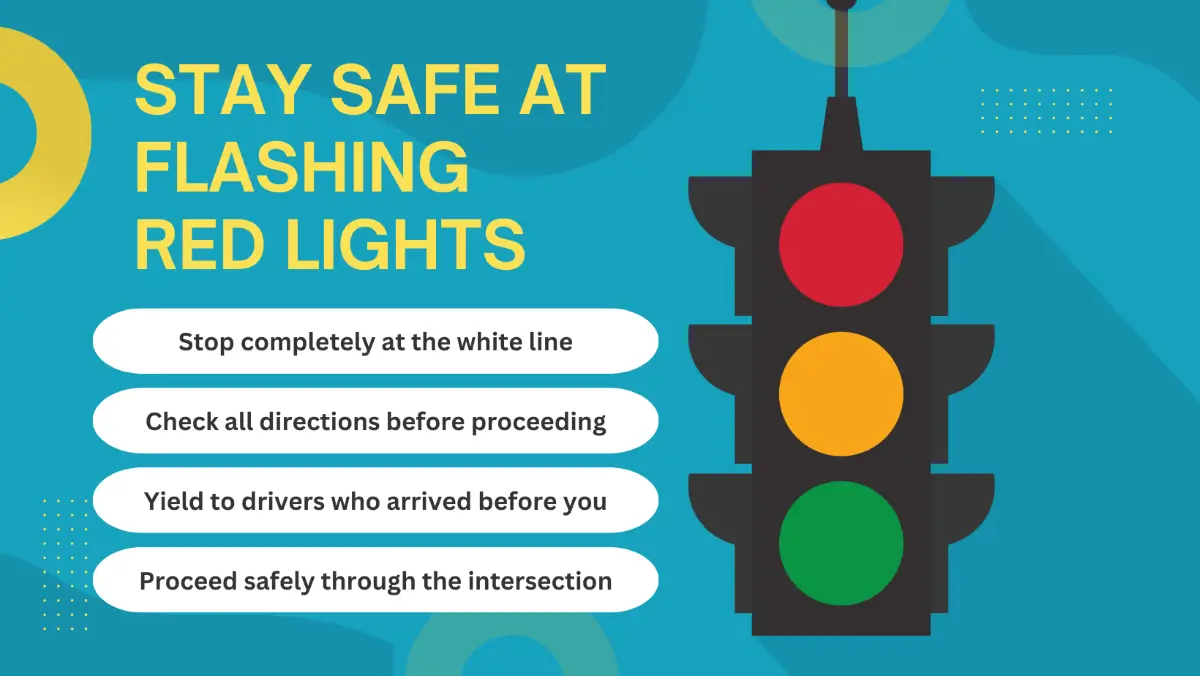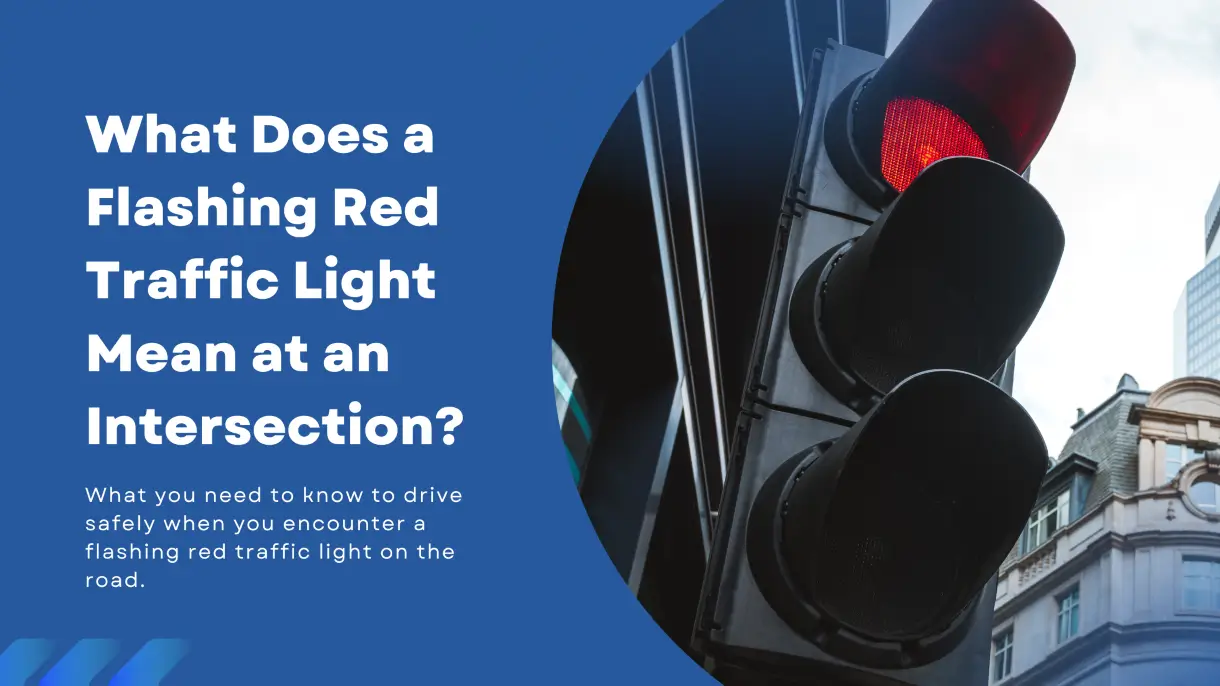Approaching an intersection with a flashing red traffic light can evoke uncertainty as the flow of traffic is disrupted, and understanding what it means is crucial for safe navigation.
A flashing red light indicates that drivers must come to a complete stop, treat it as a stop sign, and yield the right-of-way to vehicles on the intersecting road. This vital traffic signal serves as a warning, demanding heightened caution. Here’s how to safely navigate flashing red lights at an intersection.
Ready to see if you may qualify? Click here to get a FREE, no-obligation consultation before starting your claim.
What Should I Do At a Flashing Red Light?

If you come across a flashing red ahead, gradually slow down and come to a complete stop before the white solid line. The solid white line serves as a border to allow pedestrians to walk. It also allows room for large vehicles like semi-trucks to turn onto the intersection.
Check all directions for oncoming traffic or walking pedestrians. Pay attention to who came first in the intersection. Allow those vehicles to go until it’s your turn. You may go when it’s safe to do so.
Who Has the Right-of-Way at a Flashing Red Light?
In a four-way stop intersection, the vehicle that came to a complete stop at the traffic lights may proceed first. Look out for pedestrians, because they always have the right of way to cross the street. When the intersection is clear, they may proceed first, and the next vehicle who came after will go next when it’s clear.
According to the DMV handbook for the Laws and Rules of the Road, all vehicles, motorists, bicyclists, and pedestrians must wait for the person with the right of way. However, it’s smart not to assume other drivers will respect your right of way. Giving up your right of way can help prevent accidents.
Drivers should follow the right-of-way rule whether it’s in a controlled or uncontrolled intersection. A controlled intersection is when signs or traffic lights indicate to stop or to proceed with caution. Uncontrolled intersections do not have signs or traffic lights, which can happen when traffic lights break.
Nevertheless, drivers should follow the right-of-way rule even when the intersection has no signage. Failure to obey the right-of-way rules will cause car accidents and put everyone on the road at risk.
When Drivers Stop at the Same Time
Sometimes, there are instances where multiple drivers will approach a flashing red light at the same time. The general rule of thumb is to allow the driver who came first to go first. If it’s difficult to discern who came first, it’s typically expected for drivers to yield to the car on their right.
When you see both drivers facing opposite intersections, signal if you are making a turn. If the drivers are going straight or making a right turn, they can do so when there are no pedestrians or bicyclists. If you’re turning left, you’re expected to yield to drivers who are going straight, as they have the right-of-way.
Again, never assume drivers will yield you the right-of-way. Giving up your right-of-way can prevent an intersection action caused by flashing red traffic lights.
What Causes Flashing Red Lights at a Traffic Signal?
Flashing red traffic lights at an intersection typically indicate one of two things:
- Malfunction: The flashing red lights can signal a malfunction or issue with the traffic signal system. This could be due to a power outage, wiring problem, or some other technical fault. In such cases, drivers are usually required to treat the intersection as a four-way stop sign, proceeding with caution and yielding to other vehicles as appropriate.
- Temporary Control: In some cases, flashing red lights might be intentionally activated to indicate temporary control of an intersection, such as during non-peak hours or when traffic patterns are different due to construction or an event. Again, drivers are expected to treat the intersection as a four-way stop and proceed with caution.
It’s important for drivers to be familiar with local traffic laws and regulations regarding flashing red lights, as they can vary by jurisdiction. In any case, when encountering flashing red lights at a traffic signal, drivers should proceed with caution and be prepared to yield the right-of-way as necessary.
Types of Flashing Red Lights on the Road: What Do They Mean?
Flashing Red Light at a Railroad Crossing
A blinking red light at a railroad crossroad warns of an approaching train. When coming across a red flashing light near a railroad crossing, stop before the solid white line as you would before a traffic red light. Keep a distance from the railroad gate to allow the train to move safely.
Crossing the railroad gate under a red light is illegal and dangerous. Drivers may cross the railroad legally even when it’s flashing only if under the guidance of a law officer or a railroad employee.
Flashing Red Light at a School Zone
In some areas of the country, drivers may find blinking red lights in a school zone. These lights are only active during periods where children are likely to be on the roads, such as the hours before or after school. Flashing lights in a school zone typically mean to drive slow and drive with extra caution due to the risk of hitting a child.
Flashing Red Light at a Traffic Light With a Sensor
Some traffic signals come equipped with a sensor that can detect periods of low traffic. These signals, when there are no cars or pedestrians on the road, will switch to a flashing red stoplight mode in order to save energy. Although this mode is intentionally used, drivers should still treat it as a four-way stop when they encounter these flashing traffic lights on the road.
Flashing Red vs Flashing Yellow: What Does a Flashing Yellow Light Mean?
Where a flashing red light means to stop and act as though you’re at a stop sign, a flashing yellow light means to proceed with caution. Drivers don’t need to stop when approaching a blinking yellow light unless they see pedestrians or bicyclists crossing the road. Pedestrians always have the right-of-way, so under a flashing yellow, drivers must allow pedestrians to cross and may go when it’s clear.
Flashing yellow lights are common in busy intersections such as nearby schools or during construction. Some states also use a flashing yellow arrow to indicate that drivers may make an unprotected left turn. In general, it’s there to help signal drivers to be more cautious of their surroundings.
Who is At-Fault in a Flashing Red Light Accident?
Intersections are dangerous because they have drivers speeding up, slowing down, and making risky turns. According to NHTSA, an accident occurring in an intersection is likely due to:
- Driver’s error
- Not looking in all directions
- Illegal maneuvering (illegal U-turns, failing to stop, wrong turns, etc.)
- False assumptions about other driver’s actions
- Wrongly estimating the gap or drivers’ speed
- Driving under the influence of alcohol or drugs
When there’s a flashing red light at an intersection with traffic signals, there’s a possibility the lights malfunctioned and caused the auto accident to happen. In such a case, the agency responsible for its operation will compensate for all the damages and losses. The fault may be towards one or more parties.
Calling up an independent third-party investigation may be necessary to determine the cause of the accident. Witness reports, camera footage, and other crucial documentation will be important in an accident investigation.
In cases where the traffic lights are working, the fault may lie with the driver who disobeys the right-of-way rule. It may be difficult to determine who is at fault. Therefore, finding an auto accident attorney can help determine which party is liable.
Find Legal Assistance to Cover Your Car Crash Losses
Find legal assistance if you believe you’re not at fault in your auto accident to secure compensation for your injuries and losses. Our team has helps clients find the right attorney to help them with their auto insurance cases.
If you are concerned about the high costs and risks, do not worry. Auto accident attorneys work for contingency fees. This means you may not pay anything unless your settlement award goes through, leaving no risk to you! Click the button below to connect with an attorney now.
Ready to see if you may qualify? Click here to get a FREE, no-obligation consultation before starting your claim.
Cassandra Nguy
Cassandra Tran Nguy is a legal writer living in Los Angeles, California. She graduated cum laude from California State University, Northridge with a B.A. in English Creative Writing and a minor in Marketing. Visit her online profile at linkedin.com
